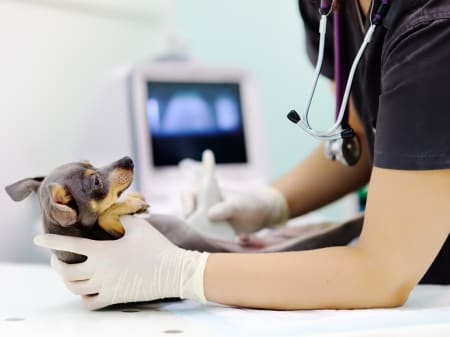What is an ultrasound?
Experienced pet owners understand that their four-legged family members are curious.
Therefore, they can easily get into things they shouldn’t, or end up with cysts or tumors that require treatment. Ultrasounds transmit sound waves into your pet’s body to produce an image of a specific part of the body.
This technology is non-invasive and can be used to diagnose pericardial effusion and hemoabdomen (blood around the heart and in the abdomen).

Why would my pet need an ultrasound?
An ultrasound can help us examine the structure of your pet’s organs so we can discover and identify blockages or objects.
At Providence Animal Hospital in Charlotte, ultrasounds are done in our in-house veterinary diagnostic laboratory. Our vets use ultrasounds and other diagnostic tools to provide an accurate diagnosis of your pet’s medical issues, so we can give effective treatment.
Using the ultrasound, we can distinguish soft tissue masses from foreign bodies or fluid - a task we might find challenging or impossible to accomplish with a digital x-ray. The sound waves the ultrasound generates are not harmful or painful to your cat or dog.
Following are specific examples of conditions that might require an ultrasound:
Heart Conditions
If your cat or dog is diagnosed with a heart condition, your vet may perform an echocardiogram to find out whether your pet will require heart medication.
Abnormal Blood or Urine Test Results
If your vet discovers abnormalities in your pet’s blood or urine tests, he or she may recommend an abdominal ultrasound so they would be able to see internal organs such as the lymph nodes, spleen, kidneys, liver, urinary bladder or other areas to learn why the abnormalities are occuring.
Examination of Soft Tissues
Almost all soft tissues can be examined with an ultrasound to assess:
- Ligaments
- Eyes
- Fetal viability and development
- Tendons
- Thyroid glands
If your vet identifies abnormal tissue during an ultrasound, they may use the ultrasound to collect tissue samples.
How are samples collected?
Samples are typically collected using these methods:
- Tru-Cut biopsies
- Ultrasound-guided fine needle aspiration
If your vet needs to use these methods, your dog will occasionally be sedated. We can perform biopsies in a less invasive manner with ultrasounds than with surgeries.
Types of Ultrasounds
Your vet may perform these two types of ultrasounds:
Emergency Ultrasound
If your pet is experiencing an emergency, the ultrasound will usually focus on the abdomen and chest to quickly learn whether your dog or cat has a serious internal hemorrhage (bleeding) or pneumothorax (a condition in which gas or air collects in the space surrounding the lungs).
This can assist us in diagnosing the issue quickly. We can then plan effective treatment.
Echocardiogram
Also referred to as cardiac ultrasounds, with these detailed ultrasounds we can closely assess the heart and its surrounding structures, including the pericardial sac. This will tell us whether the heart is functioning properly, and whether there is a malfunction in the heart.
Though they are usually painless, echocardiograms require several measurements and calculations. If your pet was recently diagnosed with a heart murmur or is displaying signs of heart disease, he or she may need an echocardiogram.
Once we identify an abnormal part of an organ, a precise biopsy of a specific area can be taken using a technique referred to as an ultrasound-guided biopsy. This biopsy allows us to take a tissue sample, which can be inspected with a microscope to reveal more information. In many cases, this will result in a diagnosis.
How should I prepare for a veterinary ultrasound?
Discuss how to prepare for the ultrasound with your vet. No special prep is required if the heart will be studied.
You may be required to withhold food and water for between 8 and 12 hours, particularly for abdominal ultrasounds. We can best examine the urinary bladder when it is full or urine. This is why your cat should not urinate for about 3 to 6 hours before the ultrasound, if possible.
The area to be examined will likely be shaved so clear images can be produced. While most pets will remain still and cooperative during the ultrasound, some will need to be sedated.
If biopsies need to be done, your cat or dog will need a heavy sedative or short-acting anesthetic to help him or her relax during the procedure, and prevent potential complications that could impede success. Your veterinarian will let you know if this is necessary.
When will I find out the results of the examination?
Because our vets can perform an ultrasound in real time, we can see results almost immediately. In some cases, ultrasound images will be sent to a veterinary radiologist after they’re captured for more consultation. In these cases, you may need to wait a few days for the final result.
Note: The advice provided in this post is intended for informational purposes and does not constitute medical advice regarding pets. For an accurate diagnosis of your pet's condition, please make an appointment with your vet.
